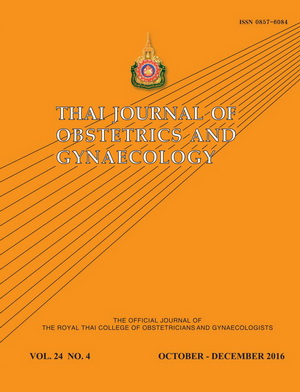Sexual Function in Women Using DMPA Injection and Copper Intrauterine Device
Main Article Content
Abstract
Objectives: To study sexual function and the prevalence of sexual dysfunction in women using depot medroxyprogesterone acetate (DMPA) and copper intrauterine device (copper IUD) contraceptives.
Materials and Methods: A cross-sectional study was conducted from May 2014 to April 2015 between 88 DMPA users and 88 copper IUD users, aged 25-40 years, who attended the Family planning clinic, Ramathibodi Hospital. Data were collected using a self-administered questionnaire. Information about sexual function over the previous 4 weeks was assessed using the Thai version Female Sexual Function Index Questionnaire (FSFI).
Results: The mean age of DMPA and copper IUD users was 30.51±4.67 and 31.66±3.59 years old, respectively (P > 0.05). All demographic and basis clinical characteristics between two groups were similar. Regarding sexual function, overall and 5 individual domain scores (desire, arousal, lubrication, orgasm and satisfaction) of the FSFI were not different. The only statistically significant difference in FSFI scores was pain domain, which was 4.66±0.94 and 5.11±0.82 in DMPA and copper IUD users, respectively (P < 0.05). The prevalence of sexual dysfunction in DMPA and copper IUD users was 77.3% and 80.7%, respectively.
Conclusion: The prevalence of female sexual dysfunction in DMPA and copper IUD users were rather high. Although the overall sexual function between DMPA and copper IUD users were not different, but sexual pain was found in DMPA users more than copper IUD users.


